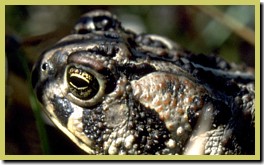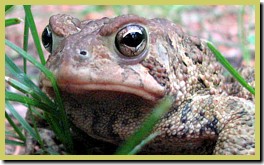
Garden Toads - “Trolls under the leaves.”
Homes for WildlifeWhen a gardener creates a home for plants and flowers, he or she may
be unwittingly creating homes for wild animals. Habitat for wildlife,
large or small, is simply a place where an animal can live; that is,
somewhere it can find food, water, shelter and enough space to live.
It doesn’t matter to the animal whether that habitat occurs in
the wild or There are four kinds of toads in Manitoba: the American toad, a woodland species found east of Winnipeg; the Canadian toad, a grassland species found in the western part of the province; the Great Plains toad, in the far southwest corner; and the plains spadefoot toad, in the Carberry Sandhills region. If your yard is near their habitat in the wild, one of these toads could show up in your garden. Even in the heart of Winnipeg, Canadian toads are common. |
||
Some Toad BiologyToads are small animals, a large one could sit comfortably in the palm of your hand. And, no, you won’t get warts from picking one up. Warts that we humans get are caused by viruses, and you get these viruses from other people, not toads. A toad’s warts are natural bumps in it’s skin that serve as camouflage. Some of the larger warts are glands which hold noxious chemicals that protect the toad from some predators. Cats and dogs are usually repelled by the taste of a toad. Their main enemies are garter snakes, which are immune to the toad toxins. (Garter snakes sometimes make their way into gardens, too, but that’s another story.) If you do pick up a toad, you’ll notice that its skin is quite soft and dry. Of all our amphibians, toads, with their thicker, drier skin, are the best adapted to live in conditions far from ponds or other wetlands. Toads are beneficial because of their appetite for garden pests. They eat a variety of insects and invertebrates, including beetles, ants, mosquitoes, centipedes and even slugs. Toads find their food by sight; their vision is extremely sensitive to motion. If something moves and is small enough to fit into it’s mouth, a toad will eat it. They do most of their feeding at night and spend the day light hours hiding under cover. Having toads in your garden depends on where you live. Toads, like all amphibians, are tied to bodies of water where they can lay their eggs and where their young, the tadpoles, can grow up. They prefer to breed in small ponds where there are no fish to eat their eggs. If you live near a pond, creek, ditch or even somewhere where there are deep snow-melt ponds that persist until late June, then you could have toads around. The eggs hatch quickly and the tadpoles grow rapidly. Eggs laid in early May can result in tiny new toads, less than 1cm long, called toadlets, by late June or early July. |
||
|
||
Toads in the Garden
Improving the habitat for toads in your yard will help encourage their presence. They need places to hide in the day time, and cover to escape to if a neighborhood cat happens by. Thick vegetation, low shrubs or small brush piles offer good shelter. You can even make “toad houses” out of old clay pots sunk partially into the ground or bricks or rocks arranged to make small caves. A backyard pond could become a home for tadpoles, too. If there are toads in your neighborhood, they will use any convenient water source for their eggs. Make sure the pond is at least 20 cm deep, and has sloping sides for the young toadlets to crawl out when they are ready. Don’t worry about feeding them, they will be happy eating algae that naturally occurs in any pool of water. In winter, toads burrow down below the frost line in soft or sandy soil to hibernate, or they will head down burrows left by ground squirrels or other small mammals. Soft soil under a compost heap would make a great place for toads to spend winter. In ClosingDon’t be surprised to see a toad in your garden, be happy! This real live “garden troll” is helping keep your plants free of insect pests at no charge. It’s just the toad’s way of paying for its room and board.
More on toads in NatureNorth: Amphibians of Manitoba | The Manitoba Herps Atlas |
||
| You can help NatureNorth produce more great articles with a secure donation through PayPal. Our Google Adsense ads pay our server costs, but that's about it. To learn more follow this link: Support NatureNorth. Thank-you! | |


